For over a half-century, James McGarrell (ANA 1992; NA 1994) has produced consistently engaging painting. Allusive, emotional, intellectual, romantic, symbolic, suggestive, surrealist, visionary—these are some of the words peppered throughout the criticism devoted to his work, yet the paintings themselves feel inexhaustible when measured against this surfeit of words. And today, as figure painting enjoys an enormous resurgence, one can’t help but feel like so many of these new inroads are well-trodden territory for McGarrell. On the occasion of his inclusion in the travelling exhibition For America: Paintings from the National Academy of Design, which is on view at the New Britain Museum of American Art in Connecticut through January 26, we discussed the show, his work, and some of the historic exhibitions he has participated in, such as MoMA’s New Images of Man and the controversial 1968 Venice Biennale.
Jeremiah William McCarthy: Perhaps the easiest place to start is with your works in the Academy’s permanent collection. Bison Self-Portrait is included in the final section of For America, which is largely devoted to recent National Academician work, and The Painter, Young and Old (Edwin Dickinson), is reproduced in the accompanying exhibition catalogue alongside the iconic self-portrait by Dickinson (ANA 1948; NA 1950).
James McGarrell: It was only years after I did the series Young and Old, which depicts twelve 20th-century artists confronting their younger selves, that I thought the proper place for the Dickinson painting would be the Academy, in the company of his self-portrait. Since most of the other paintings from the series were going into museum or private collections, I made a second donation beyond my ANA diploma piece.1
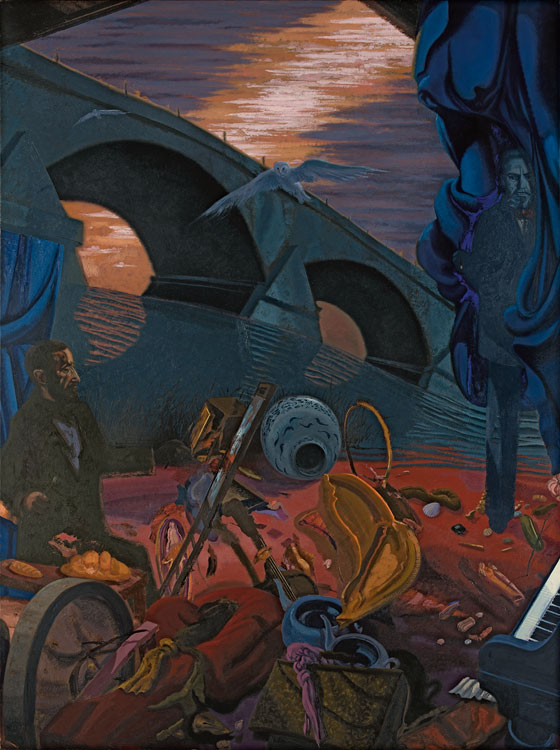
Your other diploma presentation, Bison Self-Portrait, was my first exposure to your work. To be completely honest, it’s not a very easy painting for me. I can’t reliably say I know what the hell is going on in this picture. [Laughter] But I’m okay with not knowing, and, somehow, I think I shouldn’t really know. It depicts a painter—you at work—facing off against this large bison head, with a woman in the background showering, who also appears in the painting within the painting in the right foreground.
Your uncertainty only relates to its subject, but not to your experience of the painting. Some “correct” interpretation from me would likely only diminish your surprise enjoyment of it.
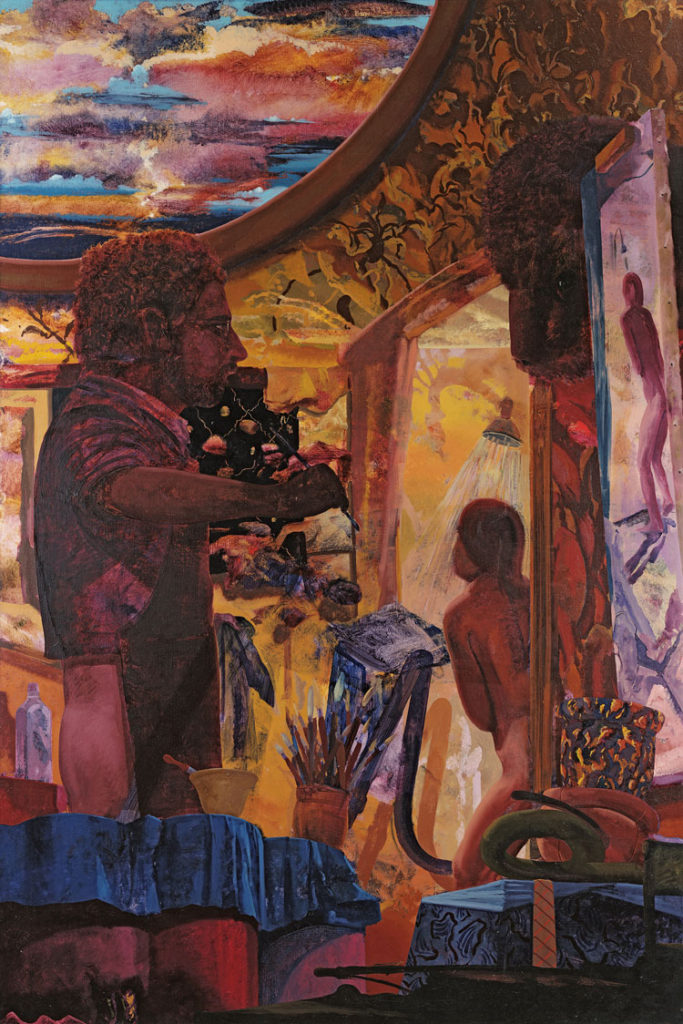
How do you know when to put the brush down with this kind of painting?
I feel a kind of rightness. This has never been a problem for me. However, for the first time ever, I recently returned to some earlier pieces as the starting point for new work, and only a few shards of their older selves remain. That’s a different ballgame!
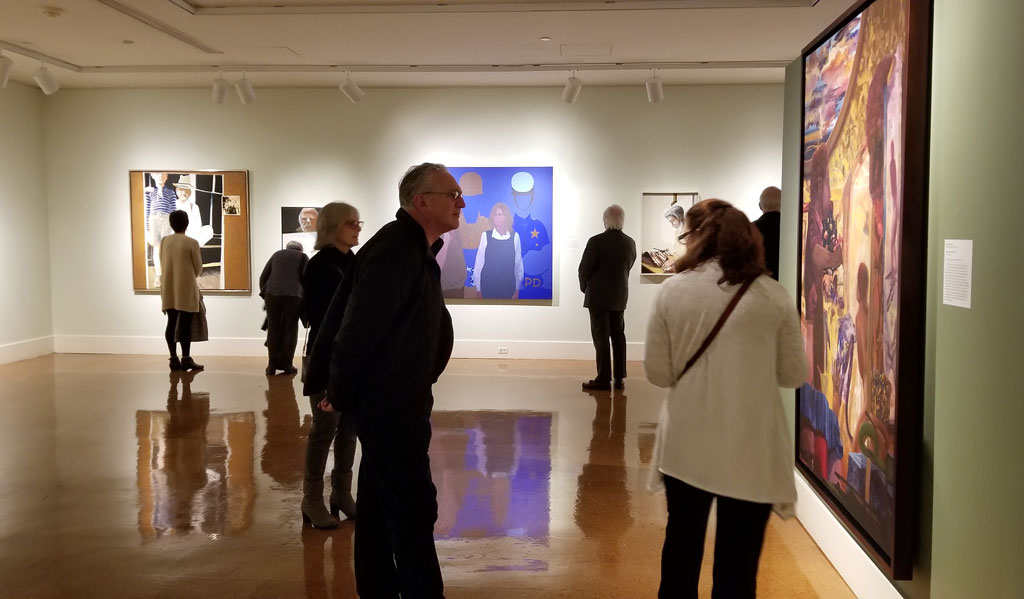
When I attended the public opening of For America at Dayton Art Institute, a crowd of college folks were standing in front of this work in the final gallery. Each one had a completely different idea about what was happening in the picture—some very strong opinions, actually. A mentor of mine, Rika Burnham, once said something like, “Some paintings read us as we read them.” It seems particularly true with your work.
Good. That’s the top thing I can hope for it! [Laughter]
When people go to this exhibition, and they linger on some work—for example, Endangered Bobby by W. Lee Savage (ANA 1991; NA 1993)—even though they might not be familiar with the artist, they will immediately contextualize the work alongside painters today who are clearly employing the same visual language and painterly tropes. Thinking about the cities on this exhibition tour—Dayton, New Britain, Palm Beach, Davenport, Memphis, Santa Fe, and Sacramento—I hope the final section of the exhibition prompts visitors to reconsider why some of this work was omitted from a story of 20th-century art that prized abstraction; a story largely written by a handful of metropolitan institutions. I’m thinking of Emma Amos (NA 2006) and Will Clutz (NA 2005), Rosemarie Beck (ANA 1980; NA 1982) and Gretna Campbell (ANA 1987).
Rosemarie and Gretna were good friends of mine whom I greatly respected. They were never seduced in their visions by stylistic fashions.
Can we turn to the 1968 Venice Biennale now? I always understood this Biennale through the story of the Italian students, and their protests before the opening against an international exposition they perceived to be a symbol of the bourgeoisie.
And American engagement in Vietnam, of course. The protests were at the tail end of weeks of civil unrest and police intervention.
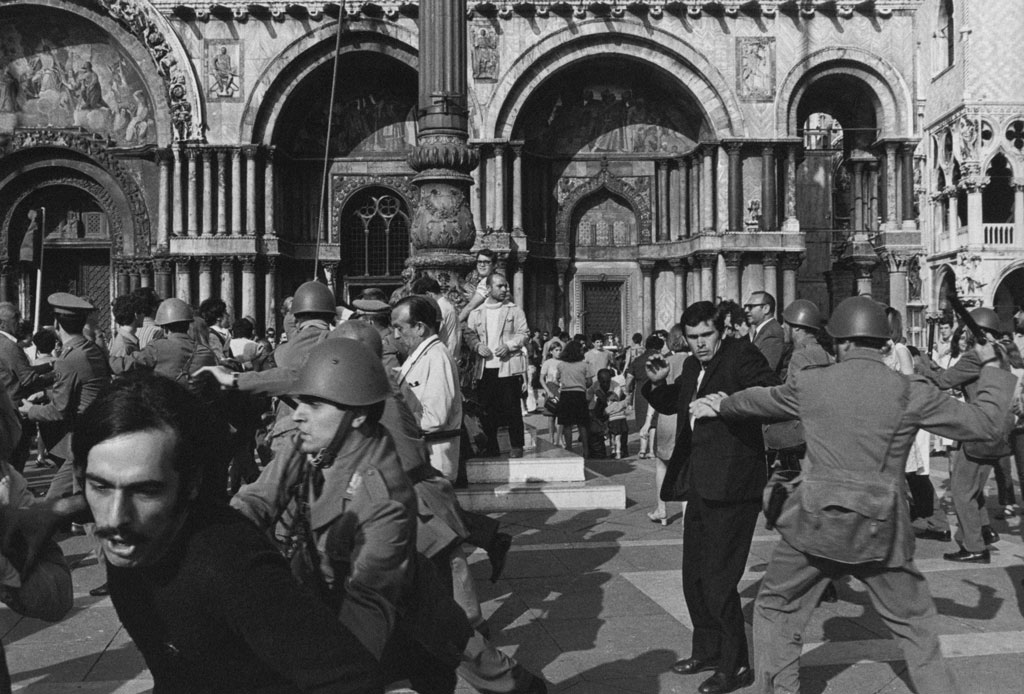
I only later learned that American critics were also taking aim at the show’s US pavilion, titled The Figurative Tradition in Recent American Art, for its aesthetic relevance. You had New York institutions like Grace Glueck going absolutely bonkers, worrying in the months leading up to the presentation that figure painters would look hopelessly marooned alongside the pop, op, and minimal work in the other pavilions. And the same with Hilton Kramer, who framed it as a retreat to conservatism following Henry Geldzahler’s “vanguard” presentation of 1966; that year’s pavilion was Helen Frankenthaler (ANA 1985; NA 1994), Ellsworth Kelly (ANA 1992; NA 1994), Roy Lichtenstein, and Jules Olitski (ANA 1992; NA 1994).
Yes, two separate, almost unrelated protests of the event happened simultaneously. One political, the other aesthetic.
It’s Fairfield Porter who said that painters have always painted figures; it’s the critics who every so often turn their attention to figures and claim it has made a resurgence, when it’s an unbroken stream to the painters.
Remember, too, this was 1968, when the cultural world was dissolving into the political one. Naturally, it invaded the Biennale so that figurative work was viewed through the lens of the day’s political unrest, causing it all to explode. While I’ve always been engaged by social and political issues, I don’t feel the art of painting is a particularly effective vehicle for me to deal with them. I was one of the figurative painters to emerge in the first generation after the dominance of Ab Ex, while Dickinson and Porter were independent from, yet contemporary, with that gang—and all of this concerning the Biennale happened after pop appeared and was viewed by many as the succeeding dominant trend; it was the stylistic front-runner. There were five American painters in the Biennale and five sculptors. Dickinson was the lead artist among the five painters, and Reuben Nakian (ANA 1985) was the lead sculptor.
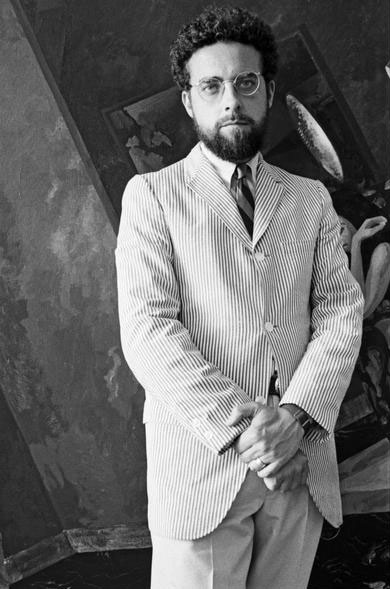
The five painters chosen were Byron Burford, Richard Diebenkorn (ANA 1979, NA 1982), Dickinson, Porter, and you. Obviously, Dickinson and Porter were a degree older, so do you know how the curator Norman Geske chose this group? Had you exhibited with these artists before?
No, and certainly never as a group.
What was Norman like?
He was very scholarly and calm, even cool, considering the pressures of the situation. After the Venice presentation, our work went on view at the National Collection of Fine Arts [now the Smithsonian American Art Museum], and then it traveled to the Sheldon Memorial [now the Sheldon Museum of Art] for the spring of 1969. Norman was the first director there, and he was a thoughtful host: he invited each of us out to Lincoln, Nebraska, separately to speak about our work and its re-presentation at his museum. He also assembled a stellar collection of 20th-century American painting there.
To my mind, what he was doing with the Venice show, which was viewed by this hostile art press at the time as being kind of retardataire, was in some ways quite forward-thinking. He understood figures weren’t going anywhere, and paintings come from paintings. In the end, he wrote a chapter of the history of our present moment where figure painting has come to the fore again. With this hindsight, it’s frustrating to read the criticism surrounding this Biennale because the show was being assailed from all sides, yet it wasn’t taken seriously on its own terms.
Yes, there was a disparity between aesthetic concerns and political contentions. Add to that the social indulgence of the New York art world at that time, of course.
Based out of Lincoln, it also seems one of Norman’s intentions was to give the international scene a taste of work made outside of New York City and Los Angeles.
I think it was a success in that sense. There are still active collectors of my work in Europe, though I’m not sure that is completely attributable to the Biennale.
You told me you only met Dickinson once. So you painted your homage much later?
Yes, I met him at that Biennale opening, but like many artists of my generation and younger, some of very different stylistic persuasions, I had always admired him as a painter’s painter.
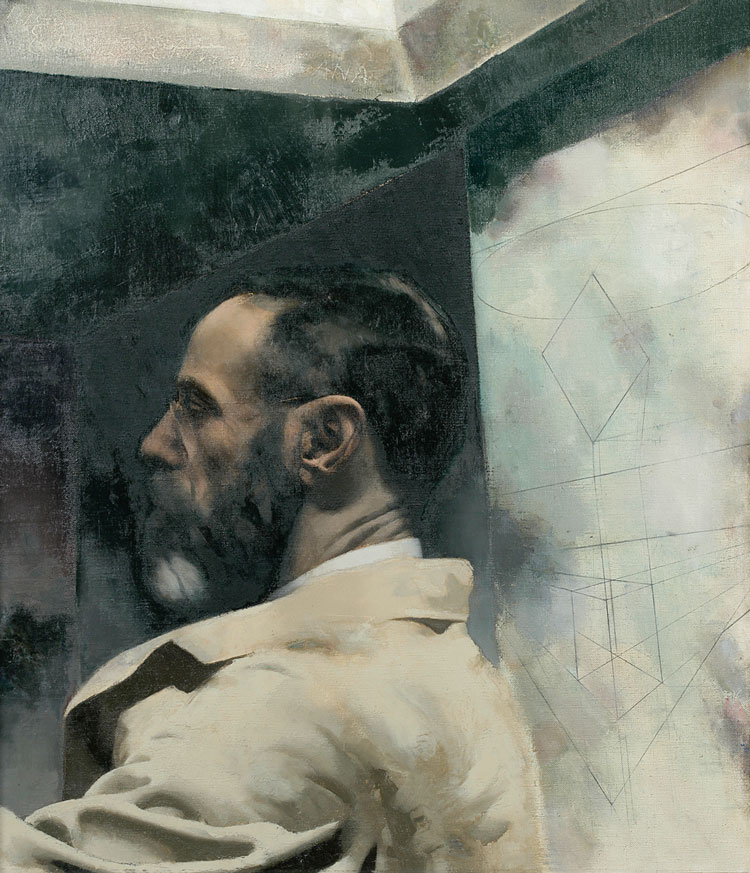
And who were the ones who influenced you?
Well, really, it was the greats from much farther back like Piero della Francesca, Titian, Diego Velázquez, the Roman fresco muralist at the Villa of Mysteries, Hans Holbein, of course Rembrandt, and later, most evidently James Ensor, Édouard Manet, and Paul Cézanne. Really it’s those landmark historical figures. And, in the 20th century, I had big eyes for Arshile Gorky.
You know he was a student at the Academy for a moment? He enrolled in a life class with Charles Hawthorne (ANA 1908; NA 1911) in 1925.
Cézanne was a big influence on him, too. I was also looking at Pierre Bonnard and Max Beckmann—who had long preceded me when I would become a faculty member at Washington University—and Lovis Corinth. Thinking back on it, I was probably most influenced by Henri Matisse, although it may not be seen in my work so much. Certainly Alberto Giacometti, too, who was included in the New Images of Man exhibition at the Museum of Modern Art in 1959.
Let’s talk about your inclusion in that.
I was the youngest artist selected at the time, and I think now the last surviving.
With New Images, there were some important American figurative painters not included—for example, Philip Pearlstein (ANA 1980; NA 1988), who essentially declares in Artnews: this version of figure painting isn’t what we’re doing; this sort of thing isn’t us. They associated the painting and sculpture in the show with an existentialist, almost nihilistic mode, and frankly it’s not hard to see why when you read Paul Tillich’s prefatory note in the catalogue.2
It was another ‘New York establishment’ response to an international exhibition that included artists from other regions of the US, like Cosmo Campoli, from Chicago, and H. C. Westermann, from Los Angeles. Pearlstein was a good friend of mine and we both showed at Allan Frumkin Gallery, but many of the other artists who chafed at the exhibition did so on the grounds of New York art chauvinism, and that limited its acceptance, rather than any broader international context.
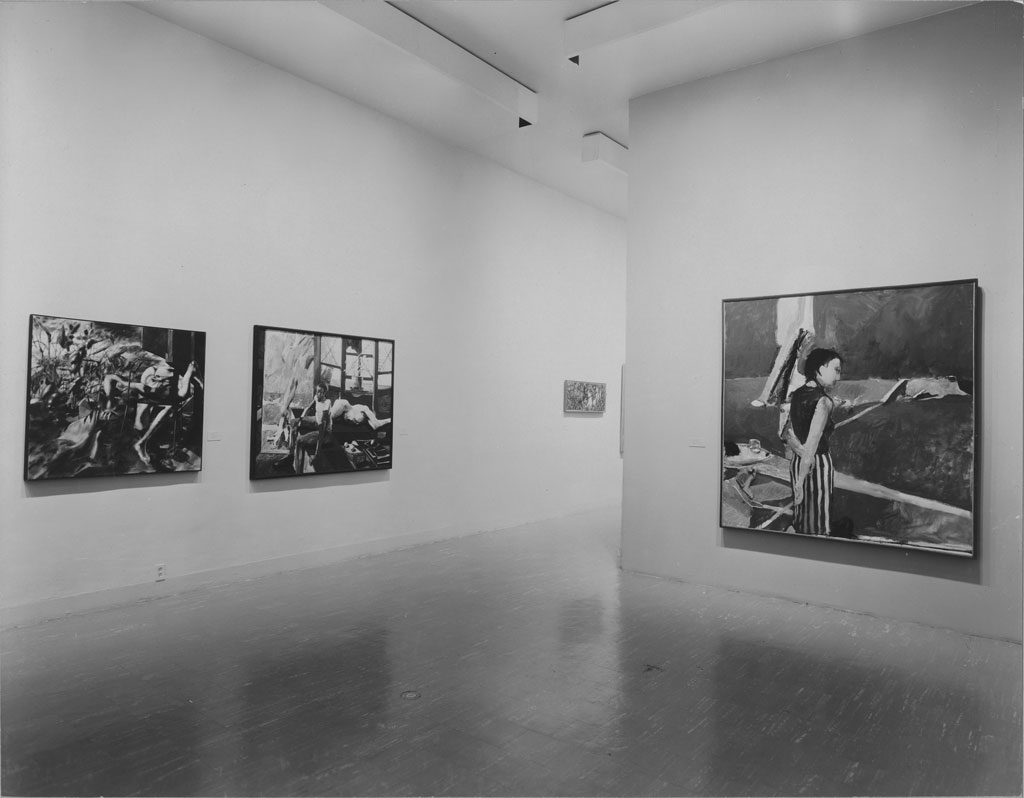
What was your feeling when you saw the show and your work was displayed alongside artists like Jean Dubuffet, Francis Bacon, Jackson Pollock, and Willem de Kooning (ANA 1980; NA 1994)?
Well, what do you think? [Laughter] I mean, I hadn’t even had my first solo show in New York yet, which was not until Allan Frumkin mounted it the following year, in 1960. Frank Perls Gallery in Los Angeles was the first gallery to show my work, which got some attention in the art press, but with Peter Selz’s invitation to this international exhibition at MoMA, I was, of course, delighted.
You’re in two major shows and both generate a spectacular amount of criticism and opinions.
Well, I wasn’t happy about that part! [Laughter] I didn’t take a licking out of New Images because the negative criticism of that exhibition was more directed towards the older generation of artists who were in it. But I certainly was noticed in the negative criticism of the Biennale.
Yet your work is consistently individual. It doesn’t appear as if you internalized any of this criticism.
I’m going to make the paintings I’m going to make without any of that figuring in the picture. I mean, of course I didn’t like it! [Laughter] But it wasn’t going to alter the way I paint. Now, many years later, my ambitions have developed and changed in many ways. For example, at the moment, I can’t say that my work has turned non-figurative, but since 2004, it no longer reads on that imagistic level. A bit like Felix Mendelssohn’s composition for solo piano, Songs Without Words, you might consider these Pictures Without Subjects.
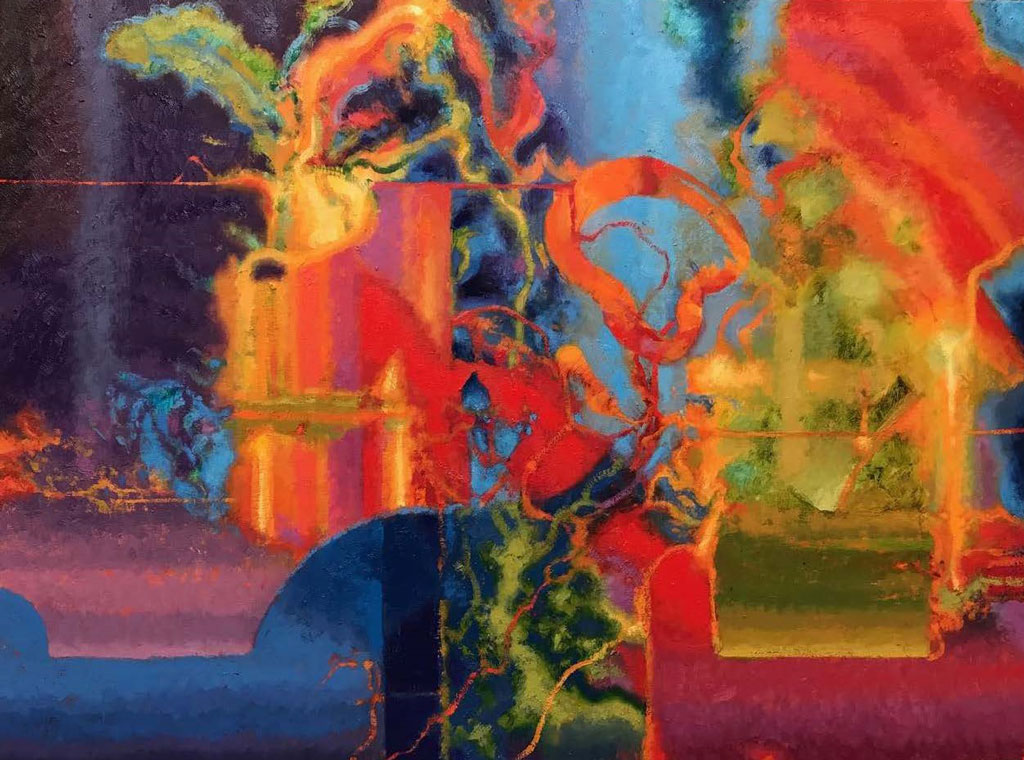
So even though you’ve stopped representing figures, you haven’t given up creating the world of light and space in which they live.
Yes, while at the same time, I hope, enhancing the formal workings on the surface—the gritty, visceral, material act of putting on the paint. All of that is very important to me. But it is also important to me that it becomes transferable into a world, even if I don’t name, or don’t want to name, or can’t help but name, what the subject matter might be. I still want to have a world beyond the surface: beyond the immediate, objective existence of the painting as a physical, visual object.
The importance of illusionism?
I’ve given up naming, but I haven’t abandoned the idea that painted physical markings can be transformed into a believable space evocative of light and atmosphere. You can have this as well as the concrete surface color and shaping.
And that’s . . .
. . . the music of the painting. The English poet Basil Bunting once said, “I am often charged with holding that music is the only important thing in poetry. Not at all, but I do maintain that music is its only indispensable element.” And that’s the way I have felt about paintings all my life.
In the beginning, you were often associated with the figurative painters of California.
Yes, and incorrectly, I think. They were mostly emerging in the Bay Area while I was still a grad student at UCLA.
You’ve also taught, and pretty consistently?
Yes, up until I retired in the early 1990s, I was teaching at Washington University in St. Louis, directing the graduate painting program there. Before that, I taught for 20 years at Indiana University at Bloomington after my first three-year faculty experience at Reed College in Portland, Oregon, at the end of the 1960s.
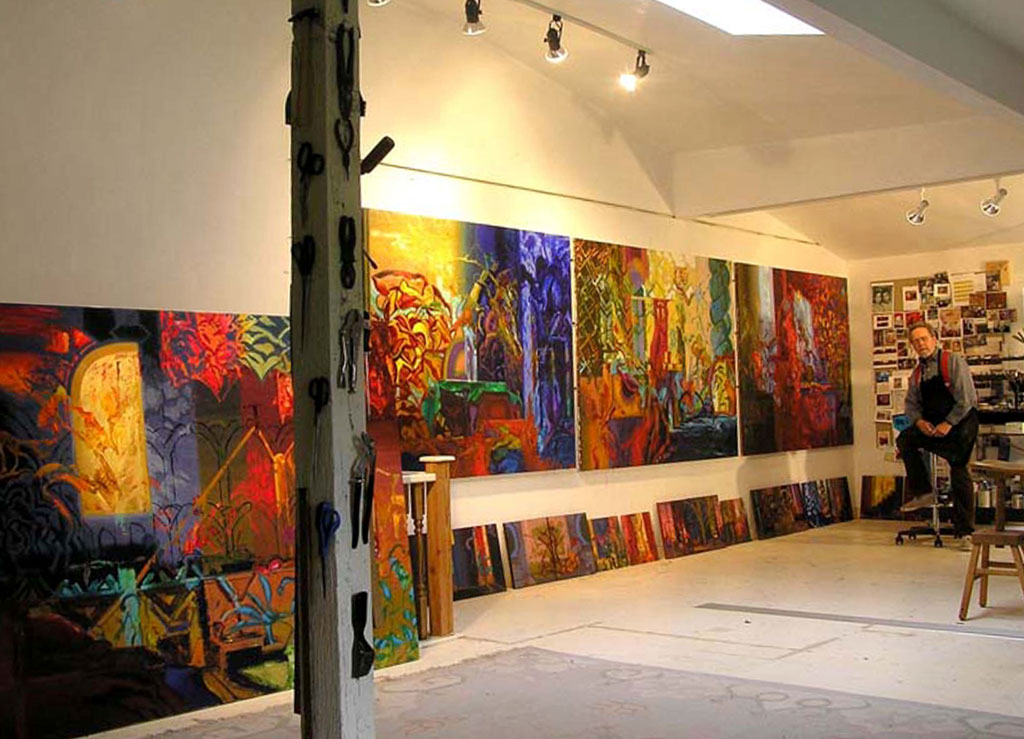
How did you teach? Was it mainly through individual critiques?
For the most part. I also collaborated with people like William Bailey (ANA 1983; NA 1994), who was my colleague at Indiana before he went to Yale, or Robert Barnes (NA 2001), or Ronald Markman. Not so much at Washington University. There, I was teaching more or less on my own and running the graduate program of painting.
How did you learn how to paint?
I’m unusual in that respect. Most American artists I know were already drawing and painting in high school art classes before they entered university or college art programs. I originally enrolled in Indiana University in a pre-law curriculum in 1948, but I had to drop out the following year to get a sweaty, dreary factory job back in Indianapolis. At that time, I was most interested in jazz, particularly its early New Orleans development, and I spent the summer of 1950 in that city. After I read all the jazz books in the Indianapolis Public Library, I moved to the art books and started painting in the basement of my home. When I finally went back to university, I remained a music buff, but became an art student.
A lot of the titles in your work come from jazz. Do you listen to jazz while you paint?
Yes, but also classical music, everything from Bach to Charles Ives, and poetry, but I only listen to poetry when it is recorded by the poet who wrote it, not some actor.
You seem to be equally comfortable with organization and systems, on the one hand, and romance and magic, on the other. There are the doubles in the Young and Old series, and the multi-paneled paintings you’ve made, the “verso variants,” which can be arranged in various horizontal configurations, all while maintaining a credible space. As controlled as they are, these pictures have wild, almost musical passages. How do you keep both ploys in play?
Those inventions like the “verso variants” are all just an armature for me, a performing musician, to play on. I almost never paint from direct eyeball vision, though I often do make drawings from models or the landscape.
When I look at many of your paintings, it’s obvious that if you wanted to, you could paint anything. For example, Equinox of 1956, which I’m staring at right now in the New Images catalogue. You were 26 when you painted it, and to create something like this, one must be able to fully understand how illusionistic representation works. Although there are improvisational passages that acknowledge the canvas as a surface, it’s a deeply thought-out composition. And with your work in the Metropolitan Museum of Art, Crossing Move, the visual symbols are culled from wide-ranging sources, from Beckmann to Balthus. When did the technique and the references come in?
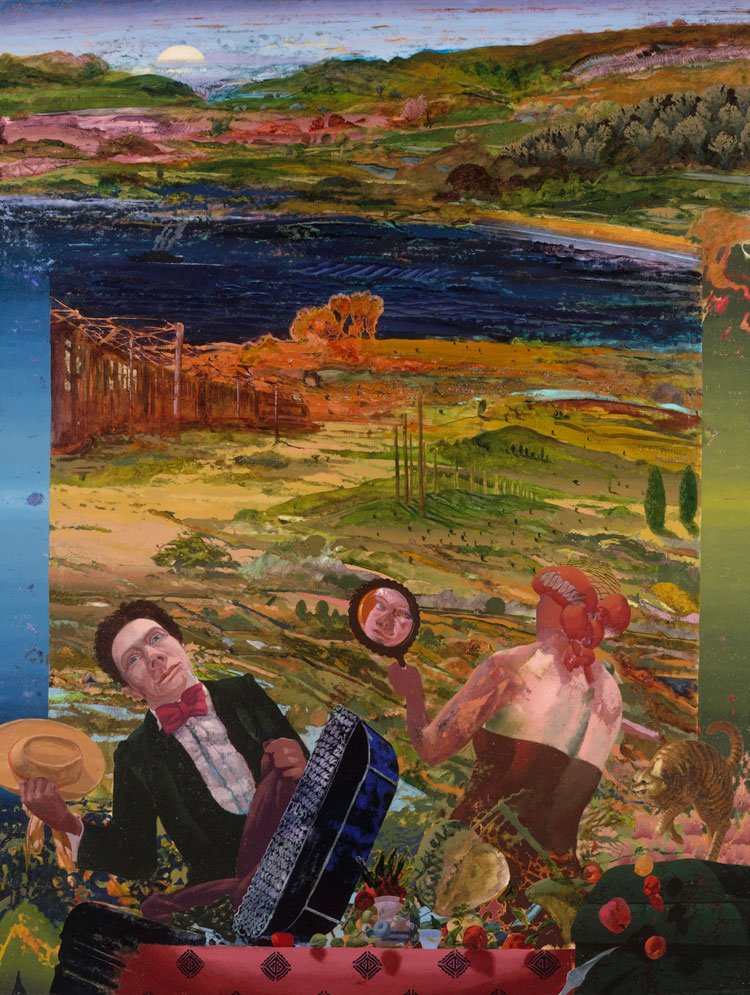
Early on as a student, I did all the basics, like drawing from life, but I was also trying to develop my own vision. I had great admiration for the Old Masters, and also for the Abstract Expressionists who were just the “new” painters, particularly de Kooning and Franz Kline, but I knew I wanted to work figuratively. I also groped around. I knew I wanted to go to a graduate program for a Masters of Fine Arts, but the chairman of the department at Indiana—Henry Hope, who was an important collector and art historian—said, “Hell no, you never go to the same school where you studied before.” Instead, he got me a teaching assistantship at UCLA, and that’s how I went to California in 1953. There, I began to work figuratively, and more and more, but with a knowledge of, an awareness of, all the factors that interested me from Ab Ex. And somehow I thought I could do figurative painting with the same kind of attitude. I don’t think I’ve ever tried to explain that in that way. [Laughter]
And where are you now?
In “real” life, I’m in Vermont. Having retired from teaching in Saint Louis, I acquired a house here in 1993 with my beloved late wife, the poet and translator Ann McGarrell. I served as an artist-in-residence at Dartmouth College the previous year, and while there we found this place in the nearby village of Newbury.
In For America we have a Vermont landscape, and coincidentally, it was created the same year as your self-portrait.
Who is the artist?
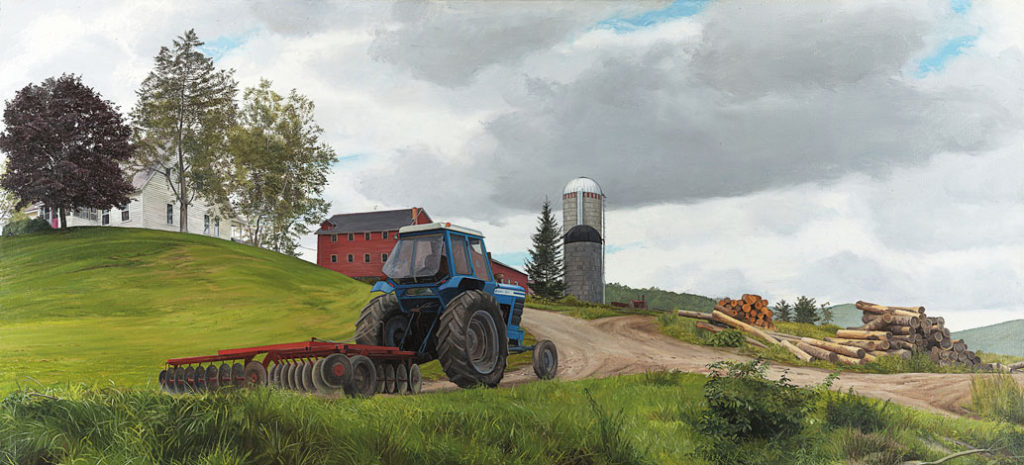
Altoon Sultan (NA 1995); the work is a deceptively simple scene of Pawlet that harks back to some of the Hudson River landscapists who open the show.
She is a fine painter. And even further up in Vermont’s Northeast Kingdom is the wonderful Claire Van Vliet (NA 1995).
Thank you, James, this was very enlightening for me. I do hope that you’re going to be pleased with the company you’re in with this catalogue and exhibition.
I’m very happy to have the painting out in the world!
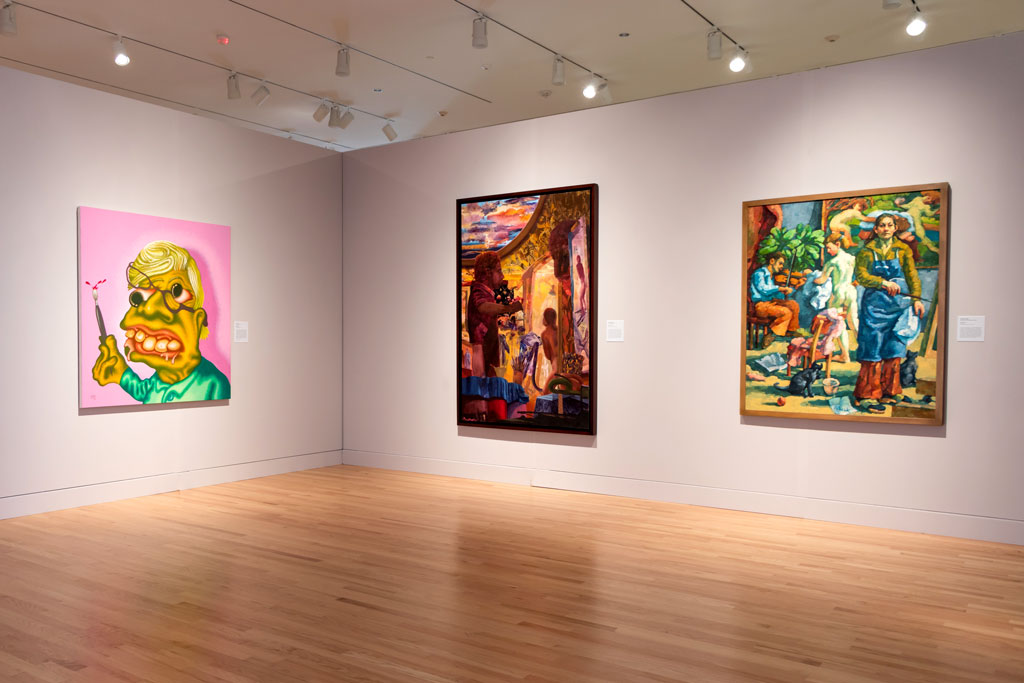
For America: Paintings from the National Academy of Design is presented by the National Academy of Design and the American Federation of Arts at Dayton Art Institute (February 20 – June 2, 2019), New Britain Museum of American Art (October 16, 2019 – January 26, 2020), The Society of the Four Arts (February 15 – March 13, 2020), Dixon Gallery & Gardens (July 19 – September 27, 2020), New Mexico Museum of Art (October 22, 2020 – January 17, 2021), Figge Art Museum (February 20 – May 9, 2021), Crocker Art Museum (June 6 – September 12, 2021), and the Oklahoma City Museum of Art (November 6, 2021 – January 30, 2022). The exhibition is accompanied by a richly illustrated catalogue.
Jeremiah William McCarthy is Curator at the National Academy of Design.
- Since its founding in 1825, the Academy has upheld a rule from its first constitution and by-laws: every elected National Academician (NA) must donate a work to the Academy’s collection, in keeping with the conventions of the royal academies of art in France and England. From 1839 to 1994, all individuals nominated to the preceding rank of Associate National Academician (ANA) were required to present a portrait of themselves for the collection, whether painted by their own hand or that of a fellow artist. Grown today to nearly 8,000 works, the Academy’s collection of diploma works is unlike any other in the United States in that it is shaped by the National Academicians and not by acquisition committees or museum officials—an artists’ art history, so to speak.
- Paul Johannes Tillich (1886 – 1965) was one of the most influential Protestant theologians of the 20th century.
